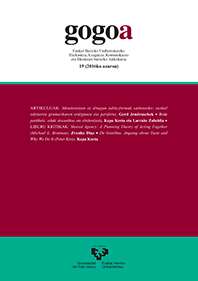The Basque particle bide: doxastic and evidential contents
##plugins.themes.bootstrap3.article.main##
##plugins.themes.bootstrap3.article.sidebar##
Published
03/02/2017
Kepa Korta
Larraitz Zubeldia
Abstract
Two kinds of meanings are usually attributed to the Basque particle bide. On the one hand, it is said to indicate the indirect nature of the speaker's evidence for the truth of the proposition at issue. According to this view, it would be a sort of inferential particle. On the other hand, bide has been associated to the expression of a certain degree of belief or certainty on the truth of the proposition. This twofold dimension of bide parallels some features of the meaning and use of another Basque particle —omen. Their morpho-syntactic behaviour, for instance, is practically identical, and their semantics and pragmatics calls for a close comparison. Then, taking as a basis our independent conclusions about omen, we examine the similarities and differences between both particles. They both point to the indirect nature of the evidence the speaker has for the assertion. But we detect two main differences. First, bide encodes an epistemic or doxastic dimension that is not present in the semantic meaning of omen. Second, bide can be taken to be an illocutionary force indicator not contributing to the truth-conditions of the utterance, whereas omen cannot.
How to Cite
Korta, K., & Zubeldia, L. (2017). The Basque particle bide: doxastic and evidential contents. Gogoa, 15. https://doi.org/10.1387/gogoa.17255
##plugins.themes.bootstrap3.article.details##
Issue
Section
Artikuluak

